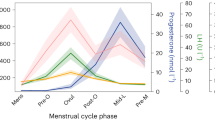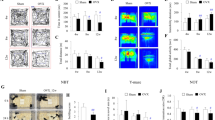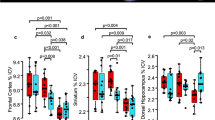Abstract
Preclinical evidence suggests that the actions of ovarian steroid hormones and brain-derived neurotrophic factor (BDNF) are highly convergent on brain function. Studies in humanized mice document an interaction between estrus cycle-related changes in estradiol secretion and BDNF Val66Met genotype on measures of hippocampal function and anxiety-like behavior. We believe our multimodal imaging data provide the first demonstration in women that the effects of the BDNF Val/Met polymorphism on hippocampal function are selectively modulated by estradiol. In a 6-month pharmacological hormone manipulation protocol, healthy, regularly menstruating, asymptomatic women completed positron emission tomography (PET) and functional magnetic resonance imaging (fMRI) scans while performing the n-back working memory task during three hormone conditions: ovarian suppression induced by the gonadotropin-releasing hormone agonist, leuprolide acetate; leuprolide plus estradiol; and leuprolide plus progesterone. For each of the three hormone conditions, a discovery data set was obtained with oxygen-15 water regional cerebral blood flow PET in 39 healthy women genotyped for BDNF Val66Met, and a confirmatory data set was obtained with fMRI in 27 women. Our results, in close agreement across the two imaging platforms, demonstrate an ovarian hormone-by-BDNF interaction on working memory-related hippocampal function (PET: F2,37=9.11, P=0.00026 uncorrected, P=0.05, familywise error corrected with small volume correction; fMRI: F2,25=5.43, P=0.01, uncorrected) that reflects differential hippocampal recruitment in Met carriers but only in the presence of estradiol. These findings have clinical relevance for understanding the neurobiological basis of individual differences in the cognitive and behavioral effects of ovarian steroids in women, and may provide a neurogenetic framework for understanding neuropsychiatric disorders related to reproductive hormones as well as illnesses with sex differences in disease expression and course.
This is a preview of subscription content, access via your institution
Access options
Subscribe to this journal
Receive 12 print issues and online access
$259.00 per year
only $21.58 per issue
Buy this article
- Purchase on Springer Link
- Instant access to full article PDF
Prices may be subject to local taxes which are calculated during checkout



Similar content being viewed by others
References
Schiller CE, Johnson AL, Abate AC, Schmidt PJ, Rubinow DR . Reproductive steroid regulation of mood and behavior. Compr Physiol 2016; 6: 1135–1160.
Jacobs E, D'Esposito M . Estrogen shapes dopamine-dependent cognitive processes: implications for women's health. J Neurosci 2011; 31: 5286–5293.
Epperson CN, Bale TL . BDNF Val66Met polymorphism and brain-derived neurotrophic factor levels across the female life span: implications for the sex bias in affective disorders. Biol Psychiatry 2012; 72: 434–436.
Pilgrim C, Hutchison JB . Developmental regulation of sex-differences in the brain - can the role of gonadal-steroids be redefined. Neuroscience 1994; 60: 843–855.
Huang EJ, Reichardt LF . Neurotrophins: roles in neuronal development and function. Annu Rev Neurosci 2001; 24: 677–736.
Ninan I, Bath KG, Dagar K, Perez-Castro R, Plummer MR, Lee FS et al. The BDNF Val66Met polymorphism impairs NMDA receptor-dependent synaptic plasticity in the hippocampus. J Neurosci 30: 8866–8870.
Yang F, Je HS, Ji YY, Nagappan G, Hempstead B, Lu B . Pro-BDNF-induced synaptic depression and retraction at developing neuromuscular synapses. J Cell Biol 2009; 185: 727–741.
Ji YY, Lu Y, Yang F, Shen WH, Tang TTT, Feng LY et al. Acute and gradual increases in BDNF concentration elicit distinct signaling and functions in neurons. Nat Neurosci 2010; 13: 302–307.
Tyler WJ, Pozzo-Miller L . Miniature synaptic transmission and BDNF modulate dendritic spine growth and form in rat CA1 neurones. J Physiol 2003; 553: 497–509.
Berman KF, Schmidt PJ, Rubinow DR, Danaceau MA, VanHorn JD, Esposito G et al. Modulation of cognition-specific cortical activity by gonadal steroids: a positron-emission tomography study in women. Proc Natl Acad Sci USA 1997; 94: 8836–8841.
Wei S-M, Eisenberg DP, Kohn PD, Kippenhan JS, Kolachana BS, Weinberger DR et al. Brain-derived neurotrophic factor Val(66)Met polymorphism affects resting regional cerebral blood flow and functional connectivity differentially in women versus men. J Neurosci 2012; 32: 7074–7081.
Egan MF, Kojima M, Callicott JH, Goldberg TE, Kolachana BS, Bertolino A et al. The BDNF val66met polymorphism affects activity-dependent secretion of BDNF and human memory and hippocampal function. Cell 2003; 112: 257–269.
Lu B . BDNF and activity-dependent synaptic modulation. Learn Mem 2003; 10: 86–98.
Luine VN, Jacome LF, Maclusky NJ . Rapid enhancement of visual and place memory by estrogens in rats. Endocrinology 2003; 144: 2836–2844.
Murer MG, Yan Q, Raisman-Vozari R . Brain-derived neurotrophic factor in the control human brain, and in Alzheimer's disease and Parkinson's disease. Prog Neurobiol 2001; 63: 71–124.
Miranda RC, Sohrabji F, Toranallerand CD . Neuronal colocalization of messenger-rnas for neurotrophins and their receptors in the developing central-nervous-system suggests a potential for autocrine interactions. Proc Natl Acad Sci USA 1993; 90: 6439–6443.
Gibbs RB . Estrogen replacement enhances acquisition of a spatial memory task and reduces deficits associated with hippocampal muscarinic receptor inhibition. Horm Behav 1999; 36: 222–233.
Sohrabji F, Miranda RCG, Toranallerand CD . Identification of a putative estrogen response element in the gene encoding brain-derived neurotrophic factor. Proc Natl Acad Sci USA 1995; 92: 11110–11114.
Shimizu E, Hashimoto K, Iyo M . Ethnic difference of the BDNF 196G/A (val66met) polymorphism frequencies: the possibility to explain ethnic mental traits. Am J Med Genet B 2004; 126B: 122–123.
Chen ZY, Patel PD, Sant G, Meng CX, Teng KK, Hempstead BL et al. Variant brain-derived neurotrophic factor (BDNF) (Met66) alters the intracellular trafficking and activity-dependent secretion of wild-type BDNF in neurosecretory cells and cortical neurons. J Neurosci 2004; 24: 4401–4411.
Hariri AR, Goldberg TE, Mattay VS, Kolachana BS, Callicott JH, Egan MF et al. Brain-derived neurotrophic factor val(66)met polymorphism affects human memory-related hippocampal activity and predicts memory performance. J Neurosci 2003; 23: 6690–6694.
Wei S-M, Eisenberg DP, Nabel KG, Kohn PD, Kippenhan JS, Dickinson D et al. Brain-derived neurotrophic factor Val66Met polymorphism affects the relationship between an anxiety-related personality trait and resting regional cerebral blood flow. Cereb Cortex 2016; bhw072; doi: 10.1093/cercor/bhw072.
Spencer JL, Waters EM, Milner TA, Lee FS, McEwen BS . BDNF variant Val66Met interacts with estrous cycle in the control of hippocampal function. Proc Natl Acad Sci USA 2010; 107: 4395–4400.
Bath KG, Chuang J, Spencer-Segal JL, Amso D, Altemus M, McEwen BS et al. Variant brain-derived neurotrophic factor (Valine66Methionine) polymorphism contributes to developmental and estrous stage-specific expression of anxiety-like behavior in female mice. Biol Psychiatry 2012; 72: 499–504.
Braver TS, Cohen JD, Nystrom LE, Jonides J, Smith EE, Noll DC . A parametric study of prefrontal cortex involvement in human working memory. Neuroimage 1997; 5: 49–62.
Owen AM, McMillan KM, Laird AR, Bullmore E . N-back working memory paradigm: A meta-analysis of normative functional neuroimaging. Hum Brain Mapp 2005; 25: 46–59.
Eriksson J, Vogel EK, Lansner A, Bergstrom F, Nyberg L . Neurocognitive architecture of working memory. Neuron 2015; 88: 33–46.
Olson IR, Page K, Moore KS, Chatterjee A, Verfaellie M . Working memory for conjunctions relies on the medial temporal lobe. J Neurosci 2006; 26: 4596–4601.
Hartley T, Bird CM, Chan D, Cipolotti L, Husain M, Vargha-Khadem F et al. The hippocampus is required for short-term topographical memory in humans. Hippocampus 2007; 17: 34–48.
Ezzyat Y, Olson I . The medial temporal lobe and visual working memory: comparisons across tasks, delays, and visual similarity. Cogn Affect Behav Neurosci 2008; 8: 32–40.
Axmacher N, Mormann F, Fernandez G, Cohen MX, Elger CE, Fell J . Sustained neural activity patterns during working memory in the human medial temporal lobe. J Neurosci 2007; 27: 7807–7816.
Bahner F, Demanuele C, Schweiger J, Gerchen MF, Zamoscik V, Ueltzhoffer K et al. Hippocampal-dorsolateral prefrontal coupling as a species-conserved cognitive mechanism: a Human Translational Imaging Study. Neuropsychopharmacology 2015; 40: 1674–1681.
Cousijn H, Rijpkema M, Qin SZ, van Wingen GA, Fernandez G . Phasic deactivation of the medial temporal lobe enables working memory processing under stress. Neuroimage 2012; 59: 1161–1167.
Finn AS, Sheridan MA, Kam CLH, Hinshaw S, D'Esposito M . Longitudinal evidence for functional specialization of the neural circuit supporting working memory in the human brain. J Neurosci 2010; 30: 11062–11067.
Dixson L, Walter H, Schneider M, Erk S, Schafer A, Haddad L et al. Identification of gene ontologies linked to prefrontal-hippocampal functional coupling in the human brain. Proc Natl Acad Sci USA 2014; 111: 9657–9662.
McEvoy LK, Smith ME, Gevins A . Dynamic cortical networks of verbal and spatial working memory: effects of memory load and task practice. Cereb Cortex 1998; 8: 563–574.
Gradin V, Gountouna VE, Waiter G, Ahearn TS, Brennan D, Condon B et al. Between- and within-scanner variability in the CaliBrain study n-back cognitive task. Psychiatry Res Neuroimaging 2010; 184: 86–95.
Baller EB, Wei SM, Kohn PD, Rubinow DR, Alarcon G, Schmidt PJ et al. Abnormalities of dorsolateral prefrontal function in women with premenstrual dysphoric disorder: a Multimodal Neuroimaging Study. Am J Psychiatry 2013; 170: 305–314.
Beck AT, Erbaugh J, Ward CH, Mock J, Mendelsohn M . An inventory for measuring depression. Arch Gen Psychiatry 1961; 4: 561–571.
Axmacher N, Elger CE, Fell J . Working memory-related hippocampal deactivation interferes with long-term memory formation. J Neurosci 2009; 29: 1052–1060.
Meyer-Lindenberg A, Poline JB, Kohn PD, Holt JL, Egan MF, Weinberger DR et al. Evidence for abnormal cortical functional connectivity during working memory in schizophrenia. Am J Psychiatry 2001; 158: 1809–1817.
Rajkowska G, Goldmanrakic PS . Cytoarchitectonic definition of prefrontal areas in the normal human cortex.2. Variability in locations of areas 9 and 46 and relationship to the Talairach Coordinate System. Cereb Cortex 1995; 5: 323–337.
Pluta J, Avants BB, Glynn S, Awate S, Gee JC, Detre JA . Appearance and incomplete label matching for diffeomorphic template based hippocampus segmentation. Hippocampus 2009; 19: 565–571.
Yeo BTT, Krienen FM, Sepulcre J, Sabuncu MR, Lashkari D, Hollinshead M et al. The organization of the human cerebral cortex estimated by intrinsic functional connectivity. J Neurophysiol 2011; 106: 1125–1165.
Cohen J . Statistical Power Analysis for the Behavioral Sciences (2nd Edition). Lawrence Erlbaum Associates: Mahwah, NJ, USA, 1988.
Faul F, Erdfelder E, Buchner A, Lang AG . Statistical power analyses using G*Power 3.1: Tests for correlation and regression analyses. Behav Res Methods 2009; 41: 1149–1160.
Faul F, Erdfelder E, Lang AG, Buchner A . G*Power 3: a flexible statistical power analysis program for the social, behavioral, and biomedical sciences. Behav Res Methods 2007; 39: 175–191.
Pike GB . Quantitative functional MRI: concepts, issues and future challenges. Neuroimage 2012; 62: 1234–1240.
Scharfman HE, MacLusky NJ . Estrogen and brain-derived neurotrophic factor (BDNF) in hippocampus: complexity of steroid hormone-growth factor interactions in the adult CNS. Front Neuroendocrinol 2006; 27: 415–435.
Spencer JL, Waters EM, Romeo RD, Wood GE, Milner TA, McEwen BS . Uncovering the mechanisms of estrogen effects on hippocampal function. Front Neuroendocrinol 2008; 29: 219–237.
Henderson CE . Role of neurotrophic factors in neuronal development. Curr Opin Neurobiol 1996; 6: 64–70.
Benraiss A, Chmielnicki E, Lerner K, Roh D, Goldman SA . Adenoviral brain-derived neurotrophic factor induces both neostriatal and olfactory neuronal recruitment from endogenous progenitor cells in the adult forebrain. J Neurosci 2001; 21: 6718–6731.
Resnick SM, Maki PM, Golski S, Kraut MA, Zonderman AB . Effects of estrogen replacement therapy on PET cerebral blood flow and neuropsychological performance. Horm Behav 1998; 34: 171–182.
Maki PM, Resnick SM . Longitudinal effects of estrogen replacement therapy on PET cerebral blood flow and cognition. Neurobiol Aging 2000; 21: 373–383.
Mulnard RI, Cotman CW, Kawas C, van Dyck CH, Sano H, Doody R et al. Estrogen replacement therapy for treatment of mild to moderate Alzheimer disease - a randomized controlled trial. JAMA 2000; 283: 1007–1015.
Hogervorst E, Yaffe K, Richards M, Huppert F . Hormone replacement therapy for cognitive function in postmenopausal women (Review). Cochrane Database Syst Rev 2002; CD003122.
Rapp SR, Espeland MA, Shumaker SA, Henderson VW, Brunner RL, Manson JE et al. Effect of estrogen plus progestin on global cognitive function in postmenopausal women - The Women's Health Initiative Memory Study: a randomized controlled trial. JAMA 2003; 289: 2663–2672.
Espeland MA, Rapp SR, Shumaker SA, Brunner R, Manson JE, Sherwin BB et al. Conjugated equine estrogens and global cognitive function in postmenopausal women - Women's Health Initiative Memory Study. JAMA 2004; 291: 2959–2968.
Shumaker SA, Legault C, Kuller L, Rapp SR, Thal L, Lane DS et al. Conjugated equine estrogens and incidence of probable dementia and mild cognitive impairment in postmenopausal women - Women's Health Initiative Memory Study. JAMA 2004; 291: 2947–2958.
Shumaker SA, Legault C, Rapp SR, Thal L, Wallace RB, Ockene JK et al. Estrogen plus progestin and the incidence of dementia and mild cognitive impairment in postmenopausal women - The Women's Health Initiative Memory Study: a randomized controlled trial. JAMA 2003; 289: 2651–2662.
Low LF, Anstey KJ . Hormone replacement therapy and cognitive performance in postmenopausal women - a review by cognitive domain. Neurosci Biobehav Rev 2006; 30: 66–84.
Yaffe K, Vittinghoff E, Ensrud KE, Johnson KC, Diem S, Hanes V et al. Effects of ultra-low-dose transdermal estradiol on cognition and health-related quality of life. Arch Neurol 2006; 63: 945–950.
Lethaby A, Hogervorst E, Richards M, Yesufu A, Yaffe K . Hormone replacement therapy for cognitive function in postmenopausal women. Cochrane Database Syst Rev 2008; CD003122.
Korol DL, Kolo LL . Estrogen-induced changes in place and response learning in young adult female rats. Behav Neurosci 2002; 116: 411–420.
Zurkovsky L, Brown SL, Boyd SE, Fell JA, Korol DL . Estrogen modulates learning in female rats by acting directly at distinct memory systems. Neuroscience 2007; 144: 26–37.
Wu YWC, Du X, van den Buuse M, Hill RA . Analyzing the influence of BDNF heterozygosity on spatial memory response to 17 beta-estradiol. Transl Psychiatry 2015; 5: 10.
Grigorova M, Sherwin BB . No differences in performance on test of working memory and executive functioning between healthy elderly postmenopausal women using or not using hormone therapy. Climacteric 2006; 9: 181–194.
Owens JF, Matthews KA, Everson SA . Cognitive function effects of suppressing ovarian hormones in young women. Menopause 2002; 9: 227–235.
Hampson E, Morley EE . Estradiol concentrations and working memory performance in women of reproductive age. Psychoneuroendocrinology 2013; 38: 2897–2904.
Singh M, Meyer EM, Simpkins JW . The effect of ovariectomy and estradiol replacement on brain-derived neurotrophic factor messenger-ribonucleic-acid expression in cortical and hippocampal brain-regions of female Sprague-Dawley rats. Endocrinology 1995; 136: 2320–2324.
Gonzalez SL, Labombarda F, Deniselle MCG, Guennoun R, Schumacher M, De Nicola AF . Progesterone up-regulates neuronal brain-derived neurotrophic factor expression in the injured spinal cord. Neuroscience 2004; 125: 605–614.
Kaur P, Jodhka PK, Underwood WA, Bowles CA, de Fiebre NC, de Fiebre CM et al. Progesterone increases brain-derived neurotrophic factor expression and protects against glutamate toxicity in a mitogen-activated protein kinase- and phosphoinositide-3 kinase-dependent manner in cerebral cortical explants. J Neurosci Res 2007; 85: 2441–2449.
Rosner W, Hankinson SE, Sluss PM, Vesper HW, Wierman ME . Challenges to the measurement of estradiol: an endocrine society position statement. J Clin Endocrinol Metab 2013; 98: 1376–1387.
Acknowledgements
We thank the National Institutes of Health 2013 Bench-to-Bedside award program (290698), the Positron Emission Tomography Department, and the Functional Magnetic Resonance Imaging Core Facility of the National Institutes of Health for their help and support. This research was supported by the Intramural Research Program of the National Institute of Mental Health, National Institutes of Health; NIH protocols: NCT00004571, NCT00001258 and NCT00001322; NIMH project #: ZIAMH002717 and ZIAMH002874.
Author information
Authors and Affiliations
Corresponding author
Ethics declarations
Competing interests
The authors declare no conflict of interest.
Rights and permissions
About this article
Cite this article
Wei, SM., Baller, E., Kohn, P. et al. Brain-derived neurotrophic factor Val66Met genotype and ovarian steroids interactively modulate working memory-related hippocampal function in women: a multimodal neuroimaging study. Mol Psychiatry 23, 1066–1075 (2018). https://doi.org/10.1038/mp.2017.72
Received:
Revised:
Accepted:
Published:
Issue Date:
DOI: https://doi.org/10.1038/mp.2017.72
This article is cited by
-
Aerobic exercise improves executive functions in females, but not males, without the BDNF Val66Met polymorphism
Biology of Sex Differences (2023)
-
SLC1A3 C3590T but not BDNF G196A is a predisposition factor for stress as well as depression, in an adolescent eastern Indian population
BMC Medical Genetics (2020)
-
Epigenetic intersection of BDNF Val66Met genotype with premenstrual dysphoric disorder transcriptome in a cross-species model of estradiol add-back
Molecular Psychiatry (2020)
-
Ovarian hormones, genes, and the brain: the case of estradiol and the brain-derived neurotrophic factor (BDNF) gene
Neuropsychopharmacology (2019)
-
Postpartum psychiatric disorders
Nature Reviews Disease Primers (2018)



